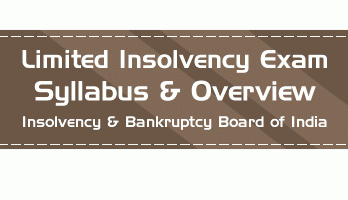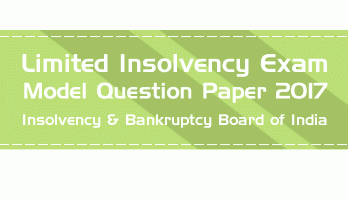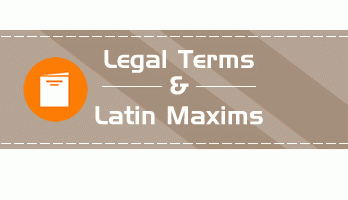This is a full-length model question paper for the Limited Insolvency Exam conducted by the Insolvency and Bankruptcy Board of India ( IBBI ), based on the current syllabus effective from 1st January 2018.
The syllabus for this exam is revised every six months, to include the latest Judicial decisions and also the recent updates in the Insolvency Laws.
Refer to the IBBI website for the syllabus for the latest exam.
1. Which of the following enactments has not been amended as part of the Insolvency and Bankruptcy Code, 2016?
a) The Indian Partnership Act, 1932
b) The Customs Act, 1962
c) The Recovery of Debts due to Banks and Financial Institutions Act, 1993
d) The Limitation Act, 1963
Ans.(d)
2. The management of the affairs of a corporate debtor undergoing corporate insolvency resolution process vests in the________
a) Interim Resolution Professional.
b) Board of Directors.
c) Committee of Creditors.
d) Insolvency and Bankruptcy Board of India.
Ans. (a)
3. Who proposes the name of the new resolution professional, if the interim resolution professional is being replaced by the Committee of Creditors?
a) Adjudicating Authority
b) Interim resolution professional
c) Insolvency and Bankruptcy Board of India
d) Committee of Creditors
Ans.(d)
4. A resolution professional shall file an application to the adjudicating authority to extend the period of fast track resolution if instructed to do so by a resolution passed at a meeting of the committee of creditors by a vote of not less than___________ percent of the voting shares.
a) 90
b) 75
c) 66
d) 51
Ans. (b)
5. The decision of admission or rejection of a claim is communicated by the liquidator to ______________.
a) all creditors and the Insolvency and Bankruptcy Board of India
b) the corporate debtor and the adjudicating authority
c) the adjudicating authority and the creditor concerned
d) the creditor concerned and the corporate debtor
Ans.(d)
6. A preference shall be deemed to be given at a relevant time under section 43 of the Insolvency and Bankruptcy Code, 2016 if it is given to a________ during the period of________ years preceding the insolvency commencement date.
a) related party, two years
b) unrelated party, two years
c) related party, three years
d) unrelated party, two years
Ans. (a)
7. Under the Insolvency and Bankruptcy Code, 2016, who is eligible to make application for avoidance of transactions if the terms of such transaction required exorbitant payments to be made by the corporate debtor?
a) A financial creditor
b) The committee of creditors
c) The corporate debtor
d) The resolution professional
Ans. (d)
8. Which of the following is an excluded asset for the purposes of Part III of the Insolvency and Bankruptcy Code, 2016 dealing with insolvency resolution and bankruptcy for individuals?
a) Unencumbered tools necessary for personal use of the debtor
b) Money received from provident fund after retirement
c) Ornaments used by self and the spouse irrespective of their usage
d) One pucca house irrespective of its value
Ans.(a)
9. A creditor may apply in relation to any partnership debt owed to him for initiating an insolvency resolution process against _______________.
a) any one or more partners of the firm or the firm
b) any one or more partners of the firm and the firm
c) any one or more designated partners of the firm or the firm
d) any one or more partners of the firm
Ans.(a)
10. The report on premature end of a repayment plan submitted by a resolution professional to the Adjudicating Authority need not contain___________
a) receipts and payments made in pursuance of the repayment plan.
b) reason for premature end of the repayment plan.
c) details of the creditors whose claims have not been fully satisfied.
d) an application for initiation of bankruptcy.
Ans. (d)
11. Who prepares the list of creditors of the bankrupt after a bankruptcy order is passed by the adjudicating authority?
a) Bankruptcy trustee
b) Bankrupt
c) Adjudicating Authority
d) Resolution Professional
Ans.(a)
12. An onerous property that a bankruptcy trustee may disclaim does not include
a) A readily saleable property
b) an unsaleable property
c) an unprofitable contract
d) a property that may give rise to a claim
Ans.(a)
13. In a bankruptcy process, unsecured creditors rank ______.
a) in ascending order of the amount of debt due to them
b) in descending order of the amount of debt due to them
c) equally amongst themselves
d) in ascending order of the period of default of the debt
Ans.(c)
14. Which of the following is not a function of an Insolvency Professional Agency?
a) grant membership to persons who fulfil all requirements set out in its byelaws on payment of membership fee
b) lay down standards of professional conduct for its members
c) monitor the performance of its members
d) register insolvency professionals
Ans.(d)
15. Any information utility which is aggrieved by an order of the Insolvency and Bankruptcy Board of India may prefer an appeal to___.
a) High Court
b) National Company Law Tribunal
c) Ministry of Corporate Affairs
d) National Company Law Appellate Tribunal
Ans.(d)
16. Which of the following members of the Insolvency and Bankruptcy Board of India may be included as Members of the Disciplinary Committee?
a) Independent members
b) Whole time members
c) Executive members
d) Nominee members
Ans.(b)
17. If an appeal could not be filed against an order of the NCLAT within the prescribed time before the Supreme Court for sufficient cause, the Supreme Court may allow the appeal to be filed within a further period of ______.
a) 15 days
b) 20 days
c) 30 days
d) 45 days
Ans.(a)
18. An officer of a corporate debtor shall be liable for punishment under section 68 of the Insolvency and Bankruptcy Code, 2016, if he has, within the twelve months immediately preceding the insolvency commencement date, ____________
a) fraudulently removed any part of the property of the corporate debtor of the value of three thousand rupees.
b) wilfully concealed any property or part of such property of the corporate debtor of the value of three thousand rupees.
c) wilfully created any security interest over any property of the corporate debtor which has not been obtained on credit.
d) wilfully made any false entry in any book or paper affecting or relating to the property of the corporate debtor or its affairs.
Ans. (d)
19. A Debt Recovery Tribunal does not have jurisdiction to entertain_________
a) a suit or proceeding by or against an individual debtor.
b) a claim made by or against a corporate debtor.
c) a claim made by or against an individual debtor.
d) a question of priorities arising out of insolvency of an individual debtor.
Ans. (b)
20. Provisions of which legislation would be applicable for the proceedings before a special court under the Insolvency and Bankruptcy Code, 2016?
a) The Code of Criminal Procedure, 1973
b) The Indian Penal Code, 1860
c) The Indian Financial Code, 2013
d) Summary Trial of Offences
Ans. (C)
23. Where all financial creditors are related parties of the corporate debtor, the committee of creditors shall comprise_________
a) all of the debenture holders.
b) all of the operational creditors.
c) insolvency resolution professional and operational creditors.
d) 18 largest operational creditors by value and one representative each of workmen and of employees.
Ans. (d)
24. In case the resolution professional receives more than one resolution plan, ______,
a) he shall select the best plan for approval by the Committee of Creditors.
b) he shall select all such plans that meet the requirements of the Insolvency and Bankruptcy Code and present them before Committee of Creditors.
c) he shall forward the plan submitted by the creditor having highest voting share.
d) he shall refer the matter to adjudicating authority for directions.
Ans.(b)
25. Which of the following is not a requirement for a company to be registered as an insolvency professional agency?
a) Its sole object is to carry on the functions of an insolvency professional agency.
b) It has a minimum net worth of ten crore rupees.
c) It is promoted by a statutory regulator.
d) It is not under the control of person(s) resident outside India.
Ans. (c)






